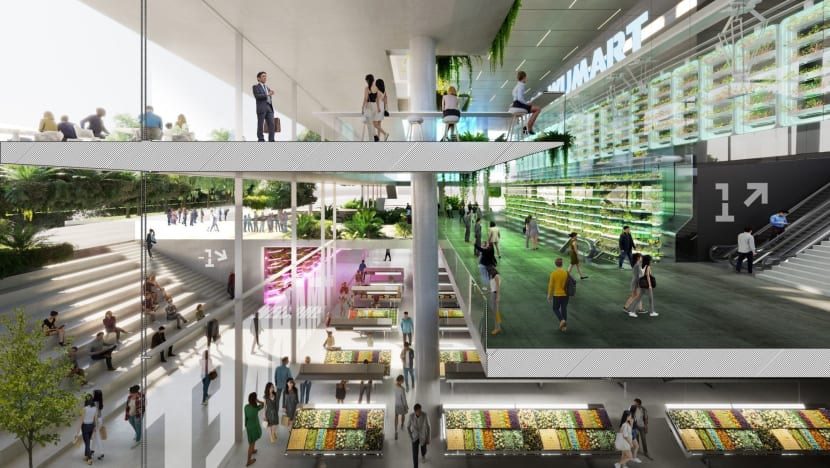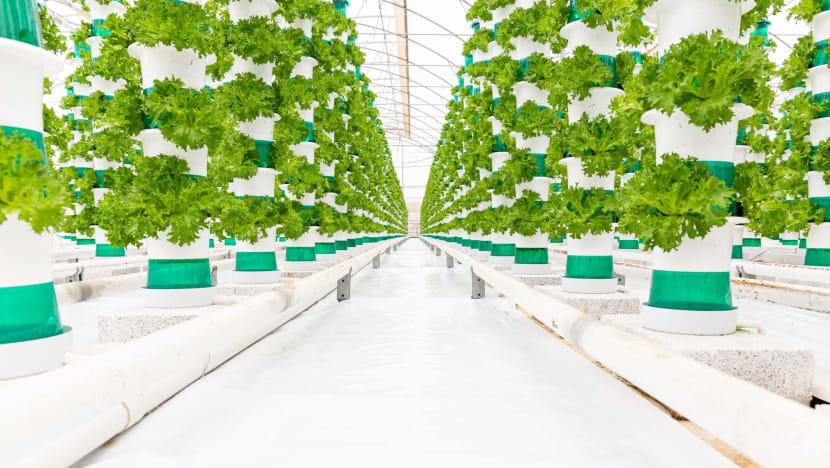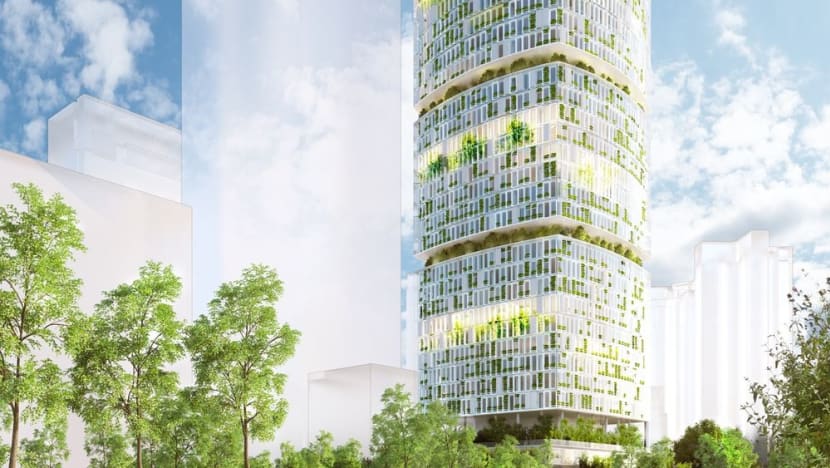Can indoor farms reach skyscraper height?

A proposed skyscraper in Shenzhen would grow food along the border of each of its 51 floors. (Photo: Carlo Ratti Associati)
As indoor farms that don’t rely on soil become a growing strategy to tackle food insecurity, one academic has a vision to take vertical farming to new heights in China’s mega-cities: The farmscraper.
Carlo Ratti, an architect who runs MIT’s Senseable City Lab, is proposing a 51-story skyscraper for China’s technology hub of Shenzhen with a large-scale vertical hydroponic farm inside that can produce crops like salad greens, berries and tomatoes to feed up to 40,000 people per year.
The proposed tower, which would include other amenities like office space, a supermarket and a food court, is being shortlisted for Chinese hypermarket chain Wumart’s new headquarters.
It’s one of a number of ideas to expand vertical farms, as breakthroughs in hydroponic and aeroponic technology allow for these indoor facilities to produce crops with higher yields using less land and water.
Vertical farms are intended to grow crops more efficiently — stacking them in trays or vertical planters in indoor climate-controlled conditions, and using algorithms and other technology to optimize light and growing conditions, often in urban environments.
In Britain, Shockingly Fresh expects to grow about 2 million heads of leafy greens a year on its first vertical farm.

And AeroFarms in Newark, New Jersey — billed as the world’s largest vertical farm when it opened in 2016 — grows about 2 million pounds of food each year on its 70,000-square-foot facility.
For comparison, Ratti’s farmscraper is projected to produce about 600,000 pounds of food annually, mostly around the facade of the 715-foot-tall building (218m).
Other dense regions like Singapore and Abu Dhabi are making big investments in vertical farming as part of their goal to produce a larger share of food locally.
In Jersey City, New Jersey, vertical farms are being constructed in public housing communities, with the aim of tackling food insecurity by merging technology, education and food access.
Other types of greenhouses that are not technically vertical farms are also relying on technologies like LED lighting and robots to optimize growing — AppHarvest in Kentucky produces 45 million pounds of tomatoes per year in a facility that it says yields 30 times more per acre than open fields, with 90 per cent less water.
In Shenzhen, Ratti says his proposal would take vertical farming “to the next level".
The proposed Jian Mu Tower would not only build taller, establishing what he says would be the world’s first farmscraper. It would also be a model for “how to integrate the natural world into building design”, by incorporating farming around the entire shell of a skyscraper where people are also working, shopping and eating.
The greenery would sit in what’s known as a double-skin facade, with windows on both sides to allow natural sunlight to reach both the plants and the building interior. Ratti says this design — and the copious amounts of sunlight in Shenzhen — will enable the farm to be less reliant on artificial light and heating, which come with high energy use.
But the farm is also intended to have benefits for the built environment: The heat that reflects off tall buildings can make a city hotter.
Encasing a skyscraper with a farm is a good way to not just mitigate this effect and keep the building cooler without air conditioning, Ratti says, but also to produce food to feed the people in that building.
“Our point was, why don’t we try to harvest this energy from the sun on the facade of the skyscraper and turn it into a giant farm,” he said. “This would not have been possible a few years ago, but it’s possible today, thanks to advances in hydroponics and also robotics.”

Global food production currently accounts for a third of greenhouse gases, 80 per cent of deforestation, 70 per cent of terrestrial biodiversity loss, and 70 per cent of all freshwater use, according to the World Wildlife Fund.
And current food production will have to increase dramatically to meet growing population demands.
Vertical farms are one vision for how to produce more crops on less land.
They’re touted as environmentally friendly, and they do use less water and fewer pesticides.
But most vertical farms use fully enclosed systems with heating and artificial LED lights that can require huge amounts of electricity.
Ratti’s reliance on sunlight is intended to tackle this criticism of many vertical farms, and other farms like Shockingly Fresh are relying entirely on natural light.
Sunlight, however, is not as consistently available throughout the year, and unlike in artificially lit farms, dark winter afternoons will mean fewer crops grown.
Ratti believes China is an ideal place for his vertical farm vision. With about 1.4 billion mouths to feed, the country needs a sharp boost in farm productivity, which has been hurt by damaged soil, contaminated water, and overuse of fertilizer and pesticides.
The government warned in September that food security could be affected by skyrocketing energy prices and in November, it urged households to stockpile food for the winter after extreme weather in October flooded crops in Shandong province, the country’s biggest vegetable producer.
Jefferies Group LLC estimates the country has 21 per cent of the world’s population with just 9 per cent of its arable land.
“The big problem in China is a lack of arable land due to really rapid urbanization,” said Alesandros Glaros, a food security researcher at the University of Guelph in Ontario, Canada.
“Vertical farming is a really innovative approach in this context because one of its big benefits is that it’s really efficient in terms of land use.”
But to solve food security and environmental concerns, Glaros said the jury is still out.
“The research is too early, I think, to make a reliable claim to saying that vertical farming is a food security solution,” he said.
“There’s just not enough data. So although there are lots of commercial operations in existence around the world, we lack a lot of good environmental data on what the exact, for example, the environmental footprint is, what the potential yield is.”
Another current limitation is that only a few kinds of crops are grown in vertical farms, mostly low-calorie foods like greens, herbs and some fruits.
So it’s not enough to sustain a population. “You're not gonna be growing things like corn or soy or wheat in these types of units,” Glaros said. Thus far, many of these farms also sell at higher organic prices, which makes the produce inaccessible to people with lower incomes.
Ratti envisions his farmscraper as a self-contained food supply chain, where the crops can be cultivated, sold and eaten all within the same building.
His proposal bears some similarities to the 2013 Asian Cairns design from the French architecture firm Vincent Callebaut Architects, which called for six modular, pebble-shaped buildings in Shenzhen also called farmscrapers, each one a self-sufficient community with its own food source and housing.

Daniel Safarik, assistant director of research at the Council on Tall Buildings and Urban Habitat, thinks a farmscraper smack dab in the middle of one of China’s most populous cities is feasible, but the challenge could come from sustaining such a structure.
“We’ve been putting green walls on skyscrapers for decades now, and some of the projects do indeed have edible produce,” he said.
“The biggest challenge is not engineering them in the first place — it’s maintenance. After the ribbon-cutting, will the owners and operators of these vertical gardens continue to maintain them at the level that an array of fussy plants will require?”
One key prong of the Shenzhen facility’s maintenance would be the use of an AI-supported “virtual agronomist” tasked with managing the farm’s day-to-day operations, including irrigation and nutritional conditions. Ratti says the difference with his newest proposal is scale. “What it really allows you to do is locally source, to produce food for tens of thousands of people just with a skyscraper,” he said.
Ratti intends to build the farmscraper whether or not his design is selected by Wumart, and expects it could take no more than three years. His design is one of just two finalists for Wumart’s headquarters, he said, but the company declined a Bloomberg request for comment.
“We’re determined to build it, with Wumart or without Wumart,” Ratti said. “It’s just about the willingness to do something the world has never seen.”














